Ever wondered why some films resonate deeply while others fall flat? The magic of cinema isn't just about breathtaking visuals and star-studded casts; it's intricately woven with a set of often unspoken "movie rules" that dictate how a story is told, a character is developed, and a genre is brought to life. These rules, whether consciously or unconsciously followed, are the foundation upon which compelling narratives are built.
Navigating the world of cinema, both as a creator and a viewer, requires understanding these underlying principles. Consider them the secret language of the silver screen, a language that, once deciphered, can unlock a deeper appreciation for the art of filmmaking. These rules affect everything from pre-production choices to the final cut, influencing distribution strategies and ultimately, audience reception. While some rules are ingrained in tradition, others are constantly evolving, reflecting changing cultural norms and technological advancements within the industry. The dynamic nature of these "movie rules" keeps the art form vibrant and engaging, but also presents challenges for filmmakers striving to create content that is both innovative and resonant. This article delves into the complex and fascinating world of "movierules," exploring their significance, the unwritten codes that many filmmakers adhere to, and the impact of these guidelines on the cinematic experience.
| Aspect | Description |
|---|---|
| Definition of Movie Rules | Informal guidelines and conventions that shape storytelling, character development, and genre presentation in films. |
| Importance | Essential for filmmakers, producers, and audiences to understand the structure and impact of films. |
| Impact on Production | Influence decisions from the production phase to distribution, including character arcs, plot pacing, and cinematic techniques. |
| Legal Compliance | Filmmakers must adhere to legal standards to ensure their work complies with copyright and distribution laws. |
| Cultural Sensitivity | Adhering to movie rules helps filmmakers create culturally sensitive content, avoiding stereotypes and promoting inclusivity. |
| Key Elements | Include storytelling techniques, character development, cinematic techniques, genre conventions, and thematic elements. |
| Audience Appreciation | Understanding movie rules enhances the viewing experience, allowing audiences to appreciate the art and narrative techniques used in films. |
| Sources of Movie Rules | These rules stem from cinematic traditions, industry standards, audience expectations, and cultural norms. |
| Evolution | Movie rules evolve with technological advancements, changing cultural norms, and audience preferences. |
| Examples of Movie Rules | Examples include: The hero's journey, three-act structure, and genre-specific tropes. |
| Enforcement | Movie rules are enforced through critical reception, box office success, and industry recognition. |
| Exceptions to Movie Rules | Creative filmmakers often break or subvert movie rules to innovate and surprise audiences, creating unique cinematic experiences. |
| Role in Filmmaking | Movie rules act as a guiding principle, helping filmmakers navigate content creation and ensure impactful storytelling. |
| Piracy and Legal Issues | Accessing pirated content, such as through Movierulz, can lead to legal trouble and penalties. Legal issues should be addressed with file hosts. |
| Movierulz | A piracy website known for leaking Tamil, Telugu, Kannada, and Hindi movies, allowing users to download content for free. |
Reference Website
- Kannada Movies 2025 Watch New Releases Movierulz Updates
- Yololary Leaks The Disturbing Truth Digital Security
In the vast landscape of online content, where access to movies is seemingly limitless, platforms like Movierulz have emerged. While promising free access to the latest Tollywood, Bollywood, and Hollywood releases, these websites operate in a legal gray area. It's crucial to understand that accessing or downloading pirated content carries significant risks. Authorities actively monitor these activities, and users who engage in such practices may face substantial penalties. Any legal concerns regarding the availability of free movies on these platforms should be directed to the actual file hosts, as they bear the primary responsibility for the content they distribute. This disclaimer is essential, as these sites often operate without the consent of copyright holders, leading to potential legal ramifications for users.
The concept of "movierules" extends far beyond the legal realm. They are the invisible threads that hold a film together, shaping character development, dictating the pacing of the narrative, and defining the conventions of specific genres. Understanding these rules allows filmmakers to create a cohesive and compelling story that resonates with audiences. For example, the classic "hero's journey" is a foundational movierule that has been used in countless films across various genres. This narrative structure, characterized by a protagonist embarking on a transformative adventure, provides a framework for character development and plot progression that is both familiar and engaging for viewers.
Consider the genre of horror, which relies heavily on established movierules to create suspense and fear. The use of jump scares, eerie music, and foreshadowing are all techniques that have become synonymous with the genre. These elements create a sense of unease and anticipation, priming the audience for moments of terror. However, the most effective horror films often subvert these rules, creating unexpected twists and turns that challenge audience expectations. This delicate balance between adhering to and breaking movierules is what makes a film truly memorable.
The Indian film industry, with its diverse range of languages and genres, also operates under a unique set of movierules. In Tollywood, Bollywood, and other regional cinemas, specific tropes and conventions have become deeply ingrained in the storytelling process. For example, the use of song and dance sequences, elaborate costumes, and melodramatic storylines are all hallmarks of Indian cinema. These elements cater to the cultural preferences of local audiences and contribute to the overall entertainment value of the films. However, as the industry evolves, filmmakers are increasingly experimenting with new techniques and genres, pushing the boundaries of traditional movierules.
The year 2024 is already bringing significant changes to the landscape of Indian cinema. With the rise of streaming platforms and the increasing globalization of content, filmmakers are facing new challenges and opportunities. They must adapt to changing audience expectations while still preserving the cultural identity and unique storytelling traditions that define Indian cinema. This requires a deep understanding of both the established movierules and the emerging trends that are shaping the future of the industry. The success of films in 2024 will depend on their ability to strike a balance between innovation and tradition, creating content that is both engaging and culturally relevant.
Platforms like Jiohotstar and Zee5 are at the forefront of this evolution, offering a vast library of movies and TV shows in multiple languages. These streaming services are providing audiences with unprecedented access to content from around the world, exposing them to a wider range of movierules and cinematic styles. This increased exposure is likely to influence audience preferences and expectations, further driving the evolution of filmmaking in India. As audiences become more sophisticated and discerning, filmmakers will need to continually innovate and adapt to stay ahead of the curve.
Understanding the "movierules" also helps in appreciating the nuances of different genres. For example, romantic comedies often rely on predictable plotlines and character archetypes, but the success of these films lies in the execution of these elements. The chemistry between the lead actors, the humor of the dialogue, and the overall tone of the film can all contribute to its success, even if the underlying story is familiar. Similarly, action films rely on visual spectacle and high-octane thrills to engage audiences, but the most effective action films also incorporate compelling characters and storylines that provide emotional depth. The ability to recognize and appreciate these genre-specific movierules enhances the viewing experience and allows audiences to connect with the film on a deeper level.
Moreover, the impact of movierules extends to the technical aspects of filmmaking. Cinematography, editing, and sound design all play a crucial role in shaping the overall cinematic experience. The use of lighting, camera angles, and music can all influence the mood and atmosphere of a film, guiding the audience's emotions and shaping their interpretation of the story. For example, a dimly lit scene with ominous music can create a sense of suspense and foreboding, while a brightly lit scene with upbeat music can evoke feelings of joy and optimism. These technical elements work in concert with the narrative elements to create a cohesive and immersive cinematic experience.
The debate surrounding movierules often centers on the question of creativity versus conformity. While adhering to established conventions can provide a solid foundation for storytelling, it can also stifle innovation and originality. The most successful filmmakers are those who are able to strike a balance between these two extremes, using movierules as a guide while also pushing the boundaries of what is possible. By understanding the underlying principles of filmmaking, they can effectively subvert expectations and create truly unique and memorable experiences for audiences. This requires a deep understanding of both the history of cinema and the current trends that are shaping the industry.
In conclusion, the concept of "movierules" is a complex and multifaceted one that encompasses a wide range of elements, from legal considerations to narrative techniques. Understanding these rules is essential for both filmmakers and audiences, as it allows them to appreciate the art of cinema on a deeper level. While adhering to established conventions can provide a solid foundation for storytelling, it is equally important to push the boundaries of what is possible and create innovative and original content. The future of cinema depends on the ability of filmmakers to strike a balance between tradition and innovation, creating films that are both engaging and culturally relevant. As the industry continues to evolve, the definition of "movierules" will undoubtedly change, but the fundamental principles of storytelling will remain the same.
The ever-evolving world of cinema in 2025 presents both challenges and opportunities for filmmakers. While established movierules provide a foundation for storytelling, the increasing demand for fresh and innovative content necessitates a willingness to break boundaries. Whether it's the latest Telugu movies or international blockbusters, audiences are seeking experiences that challenge their expectations and offer new perspectives. As streaming platforms continue to democratize access to films, understanding and adapting to these shifting movierules will be critical for success in the dynamic cinematic landscape.
- Hdhub4u Free Movies Is It Safe Legal Streaming Options
- Fix We Did Not Find Results Movie Streaming Tips 2024


